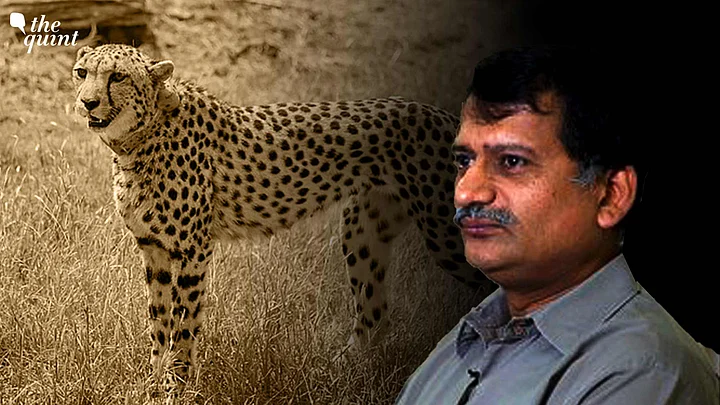"I am not sure how practical it is to repeatedly capture these cats and also the effects of such frequent capture on the cheetah’s physiology, behaviour and overall well-being," says Dr Ravi Chellam commenting on India's Cheetah Action Plan.
The acquired habitat is too small, and therefore inadequate, and the target of a population of 21 cheetahs is insufficient for a "viable and self-sustaining population". Additionally, India needs to focus on other endangered native species "which will greatly benefit from this level of attention and investment," says Dr Chellam.
The Quint speaks with Dr Ravi Chellam, a wildlife biologist and conservation scientist and coordinator of Biodiversity Collaborative, about the purpose of this experiment, the loopholes in this strategy, likelihood of its success and more, in this interview. Here are edited excerpts from the interview:
Cheetahs have been reintroduced in India with 5 female and 3 male African cheetahs being brought in from Namibia on 17th September, 2022 to Kuno National Park in Madhya Pradesh.
It has been 70 years since cheetahs went extinct in the Indian subcontinent. With the Cheetah Translocation Project put into motion, many wildlife experts and conservationists have voiced their skepticism and apprehensions concerning the necessity of this plan and its success.
The aim of this experiment is 21 cheetahs by 2037. This estimate is based on the release of at least 50 cheetahs in the next five to 10 years from Africa. Does the math add up for this plan to be a success in India, outside the cheetah's known habitat?
According to me, the fundamental weakness of the Action Plan is that they have not secured the required amount of habitat, in terms of spatial extent, for the cheetahs to establish themselves as a viable population.
The innate ecology of the cheetah is very different from that of other large cats. Even in the most suitable of habitats, they exist in very low densities of ~ 1 per 100 sq. km, when compared with other large cats like lions, tigers and leopards.
The average size of adult female home ranges in the best of habitats is ~ 750 sq.km. This gives us a clear indication of their spatial requirements. Kuno National Park is only 748 sq. km in size. At best it can accommodate 10 cheetahs.
The best-case scenario estimate mentioned in the Action Plan is double of what is possible based on scientific consensus.
Even if 21 cheetahs establish themselves as a population, it is estimated to take at least 15 years and 21 cheetahs are by no stretch of imagination sufficient to be called a viable and self-sustaining population.
At what cost does the Cheetah action plan come for Asiatic lions?
The only population of wild Asiatic lions continues to face a variety of risks (e.g., disease, natural catastrophes, forest fires) risks that would have significantly been reduced if lions had been reintroduced in Kuno to establish an additional, geographically separated and free-ranging population of lions. In wildlife conservation science it is highly recommended not to have all the members of an endangered species at a single location.
Will Kuno National Park be a suitable location for the cheetahs?
Kuno National Park does not have a resident human population and human use of this area is also highly restricted. But, if the introduced cheetahs move beyond the boundaries of the National Park, they will encounter numerous threats - vehicular traffic, domestic and feral dogs and human beings to name a few.
Conflict with local communities, especially in the form of livestock predation is also a distinct possibility.
The Action Plan states that if a cheetah ventures beyond the boundaries of the National Park, it will be captured and brought back and released back within the National Park.
Given the space limitations and because the National Park is not fenced, we can expect this to occur pretty frequently. I am not sure how practical it is to repeatedly capture these cats and also the effects of such frequent capture on the cheetah’s physiology, behaviour and overall well-being.
The aim of this experiment is to revive ecosystems. Will it succeed in doing that?
Restoration of ecosystems is a complex and long-term process. The Action Plan states that the cheetah will play its ecological role of a top predator and thereby assist with ecosystem restoration.
The best-case scenario mentioned in the Action Plan, predicts an established population of only 21 cheetahs that too after the introduction 50 African cheetahs and in 15 years’ time.
With 21 cheetahs at a single site, it is very unlikely that it would be able to influence anything at the required scales both in terms of space as well as time to contribute anything of significance with respect to restoration of ecosystems. These are too few animals, and restricted to a single site.
Do other endangered species face risks due to the prioritisation of the cheetah project?
Absolutely! We have far more endangered native species and habitats which will greatly benefit from this level of attention and investment. Great Indian Bustard, Asiatic Lion and Caracal are good examples.
The introduction of African cheetahs in not even mentioned in our National Wildlife Action Plan 2017-2031 while conservation interventions are recommended for numerous native species.
The introduction of cheetahs will significantly distract attention as well as funding from many high priority conservation initiatives.
(Dr. Ravi Chellam is a wildlife biologist and conservation scientist based in Bengaluru, India. He is the CEO of Metastring Foundation, a technology company working in the field of environment and public health and Coordinator, Biodiversity Collaborative, a network of institutions working to promote biodiversity science and its links to human well-being.)
